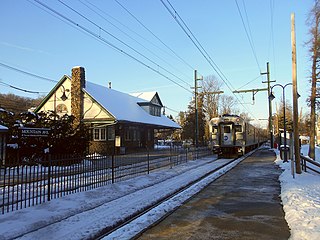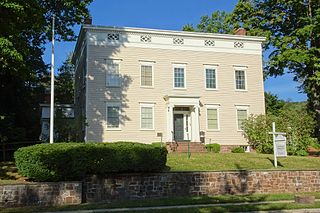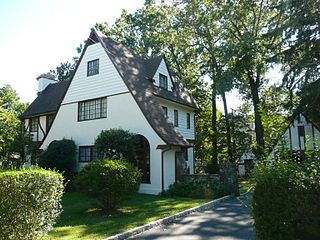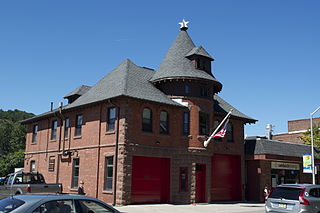
Montclair is a township in Essex County in the U.S. state of New Jersey. Situated on the cliffs of the Watchung Mountains, Montclair is a commercial and cultural hub of North Jersey and a diverse bedroom community of New York City within the New York metropolitan area. The township is the home of Montclair State University, the state's second-largest university.

Toney's Brook is a tributary of the Second River in Essex County, New Jersey in the United States.

Upper Montclair is a census-designated place (CDP), unincorporated community and neighborhood within Montclair in Essex County, in the U.S. state of New Jersey. As of the 2010 United States Census, the population for the CDP was 11,565. The area is served as United States Postal Service ZIP Code 07043. It is often misperceived, even by Montclair residents, to be a separate municipality from Montclair, perhaps aided by this postal designation.

Upper Montclair is a New Jersey Transit station in Upper Montclair, New Jersey, a census-designated place of Montclair, New Jersey. The station is part of the Montclair-Boonton Line. The station is located between two grade level crossings on Bellevue Avenue and Lorraine Avenue, and between North Mountain Avenue and Upper Montclair Plaza parallel to the railroad, and is within steps of the Upper Montclair Business District. The station is 13.7 miles (22.0 km) on the Boonton Line. Closing the grade crossing of Lorraine Avenue is being considered for safety reasons.

Mountain Avenue is an active commuter railroad station in the township of Montclair, Essex County, New Jersey. Serving trains of NJ Transit's Montclair-Boonton Line, Mountain Avenue is one of six stops in the municipality. The next station to the south/east is Upper Montclair. The next station to the north/west is Montclair Heights. Mountain Avenue contains two low-level side platforms. The station depot built by the Erie Railroad stands on the inbound platform, offering a waiting room for commuters. Part of the depot is also leased by the municipality for a residence.

The Gateway Region is the primary urbanized area of the northeastern section of New Jersey. It is anchored by Newark, the state's most populous city. It is part of the New York metropolitan area.

The Crane House and Historic YWCA is a federal-style home located at 110 Orange Road in Montclair, Essex County, New Jersey. The house has had a rich history and was added to the National Register of Historic Places on March 14, 1973, for its significance in architecture, conservation, and industry.

Anderson Park is a county park located in Montclair, New Jersey, United States. Anderson Park is part of the Essex County Park System.

Ampere, formerly known as The Crescent, is a defunct stop on New Jersey Transit's Montclair-Boonton Line in the city of East Orange, Essex County, New Jersey, United States. A station was first built there in 1890 to service to new Crocker Wheeler plant in the district. The stop was named in honor of André-Marie Ampère, a pioneer in electrodynamics and reconstructed as a new Renaissance Revival station in 1908. Ampere was the second stop on the branch west of Newark Broad Street Station until 1984, when the Roseville Avenue station was closed. In June of that year, the station, along with 42 others, was entered into the National Register of Historic Places. In 1986, after continuous deterioration, New Jersey Transit demolished the westbound shelter built in 1921. The agency discontinued rail service to Ampere on April 7, 1991. The entire station was demolished in 1995.

The House that Lives is a historic house located at 83 Watchung Avenue in the township of Montclair in Essex County, New Jersey, United States. It was built in 1922 and designed by architect Clifford C. Wendehack with Modern Movement and Tudor Revival elements. The house was added to the National Register of Historic Places on July 1, 1988, for its significance in architecture. It was listed in the Selection of Montclair's Published Houses section of the Historic Resources of Montclair Multiple Property Submission (MPS).

The Cliffside Hose Company No. 4, is located in Montclair, Essex County, New Jersey, United States. The firehouse was built in 1901 and added to the National Register of Historic Places on July 1, 1988. The firehouse was built to protect the north end of Montclair and currently houses Montclair Fire Department's Engine 2 and Truck 2.

Lackawanna Terminal is a former railroad terminal in the township of Montclair, Essex County, New Jersey. Built in 1913, the station was the terminal of the Montclair Branch of the Morris and Essex Lines. The station, boasting four platforms and six tracks, was built by William Hull Botsford, an architect who died in the sinking of the Titanic on April 15, 1912. The station opened on June 28, 1913 in a grand ceremony in Montclair. The station was used until March 2, 1981, when New Jersey Transit moved service to a single platform station at Bay Street. The station was converted to an enclosed shopping mall.

The Anchorage, also known as the Farlie House, is a Colonial Revival mansion located in Montclair, Essex County, New Jersey, United States. Designed by the architect Francis A. Nelson, the house was built in 1930 and was added to the National Register of Historic Places on July 1, 1988, for its significance in architecture. It was listed in the Montclair Architects section of the Historic Resources of Montclair Multiple Property Submission (MPS).

Casa Deldra, also known as the Anderson House, is located at 35 Afterglow Way in the township of Montclair in Essex County, New Jersey, United States. The house was designed by architect A.F. Norris and was built in 1912. It was added to the National Register of Historic Places on July 1, 1988, for its significance in architecture. It was listed in the Montclair Architects section of the Historic Resources of Montclair Multiple Property Submission (MPS).

Eastward is a historic house located at 50 Lloyd Road in the borough of Montclair in Essex County, New Jersey, United States. The house was built in 1902 for Charles R. Coffin and was added to the National Register of Historic Places on July 1, 1988, for its significance in architecture. It was listed in the Selection of Montclair's Published Houses section of the Historic Resources of Montclair Multiple Property Submission (MPS).

Stone Eagles, also known as the Mochary House, is located at 60 Undercliff Road in the township of Montclair in Essex County, New Jersey, United States. The house was built in 1929 and was added to the National Register of Historic Places on July 1, 1988, for its significance in architecture. It was listed in the Buildings by Prominent Architects section of the Historic Resources of Montclair Multiple Property Submission (MPS).

Van Reyper-Bond House is located in Montclair, Essex County, New Jersey, United States. The house was built in 1872 and was added to the National Register of Historic Places on January 22, 1979. The house is located on the campus of Montclair State University.

The Charles S. Shultz House, also known as Evergreens, is a historic house located at 30 North Mountain Avenue in Montclair in Essex County, United States. It was built in 1896 and was added to the National Register of Historic Places on July 22, 1979, for its significance in architecture.

The J. M. Chapman House is located at 10 Rockledge Road in Montclair, Essex County, New Jersey, United States. It was designed by architect A.F. Norris and was built in 1907. It has also been known as Perez House. It was added to the National Register of Historic Places on July 1, 1988, for its significance in architecture. It was listed in the Selection of Montclair's Published Houses section of the Historic Resources of Montclair Multiple Property Submission (MPS).

The Pine Street Historic District is a 26.6-acre (10.8 ha) historic district encompassing a residential section of the township of Montclair and extending into the borough of Glen Ridge, both in Essex County, New Jersey. It is roughly bounded by Glenridge Avenue, the NJ TRANSIT Boonton Line, Pine and Baldwin Streets. The district, also known as the Montclair Working Class Housing Historic District, was added to the National Register of Historic Places on March 16, 2000 for its significance in architecture and social history. The district includes 107 contributing buildings.
























